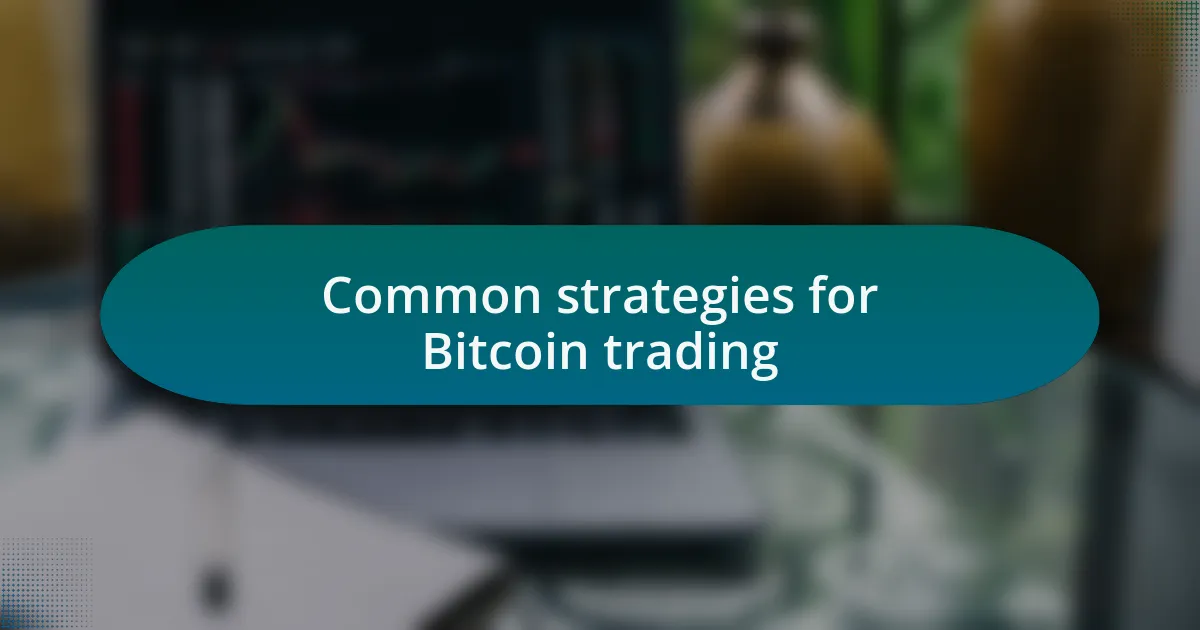Key takeaways:
- Bitcoin’s value is influenced by scarcity, market sentiment, and its potential as a decentralized financial alternative.
- Understanding cryptocurrency trends involves analyzing social media influence, trading volume, and external factors like regulations.
- Key trading strategies include day trading, dollar-cost averaging, and trend following, each requiring discipline and a well-defined plan.
- Successful trading hinges on thorough research, setting clear goals, and utilizing tools like stop-loss orders to manage risk.

Understanding Bitcoin and its value
Bitcoin is often referred to as digital gold, and for good reason. When I first invested in Bitcoin years ago, I was fascinated by its scarcity—only 21 million coins will ever exist. This limit creates a unique dynamic in its value, much like precious metals, encouraging many to see it as a store of value rather than just a currency.
The emotional rollercoaster that comes with Bitcoin’s price fluctuations is something I’ve personally experienced. I remember the thrill of watching its price soar, followed by the anxiety during sharp corrections. It raises the question: how do we gauge its true worth when emotions can swing so dramatically? Perhaps it’s about recognizing that Bitcoin’s value stems not just from its price, but also from the potential it holds as a decentralized alternative to traditional finance.
Understanding Bitcoin means diving into its utility and acceptance in the broader world. I’ve noticed that as more retailers begin to accept Bitcoin payments, its value seems to stabilize while gaining mainstream credibility. This evolution makes me wonder—are we on the brink of a financial revolution, or will Bitcoin remain a speculative asset for the time being?

Analyzing cryptocurrency market trends
Analyzing cryptocurrency market trends requires a keen eye on various indicators that can signal shifts in investor sentiment. I remember the first time I noticed how social media chatter correlated with price movements—when positive news spreads, I often see a ripple effect in buying activity. It’s like watching a crowd react to a headline; one spark can ignite a wave of enthusiasm.
Volume and market capitalization are crucial metrics too. I can’t forget the moment I realized that a sudden surge in trading volume often precedes a price jump. This understanding shifted my approach, prompting me to look beyond just the price chart. Analyzing these trends helped me make more informed decisions, but it also raised the question: if market sentiment can change so quickly, how can one stay ahead of the curve?
Then there’s the role of external factors, such as regulatory news or technological advancements. I recall feeling a mix of excitement and apprehension during significant announcements. I often ask myself: how much weight should we give to these external events in our predictions? Understanding market trends involves not only recognizing these influences but also interpreting their long-term impact on the cryptocurrency landscape.

Factors influencing Bitcoin prices
Market sentiment is one of the most significant factors influencing Bitcoin prices. I remember tracking my investments during the 2017 bull run; every tweet from influential figures sent shockwaves through the market. I couldn’t help but wonder, why do we allow such external opinions to sway us so dramatically? It’s a reminder that in this digital age, emotions often dictate our trading choices, turning speculation into a driving force behind price shifts.
Another essential factor is the supply dynamics of Bitcoin itself. When I first learned about the halving events, I was fascinated by how this built-in mechanism reduces the rate of new Bitcoin creation, similar to decreasing the flow of a limited resource. The excitement (and dread) surrounding halving events often sparks discussions around scarcity and demand—leading me to ponder, how much can future events like these influence long-term price trends?
Lastly, macroeconomic factors also play a critical role. I vividly recall the uncertainty during economic downturns when traditional markets were tumbling. It sparked conversations about Bitcoin as a “safe haven” asset, akin to gold. This made me think, can Bitcoin really serve as a hedge during crises, and how does that perception affect its value? Understanding these elements gives a more rounded perspective on why Bitcoin doesn’t just follow market trends but also dances to a broader economic rhythm.

Common strategies for Bitcoin trading
When it comes to Bitcoin trading, one common strategy is day trading, where traders buy and sell Bitcoin within the same day to capitalize on short-term price movements. I remember my first attempt at day trading; the adrenaline was high as I watched charts fluctuate every minute. It raises the question, though—how do we maintain our composure amid such volatility? Developing a solid plan and setting strict stop-loss orders became my lifeline.
Another widespread approach is dollar-cost averaging (DCA). I’ve often adopted this strategy during uncertain market phases, investing a fixed amount in Bitcoin at regular intervals, regardless of the price. It felt comforting to know that by staying consistent, I was reducing the risk of making poor decisions based on fear or excitement. Isn’t it fascinating how this method can transform our relationship with volatility, turning it from a foe into a manageable rhythm?
Lastly, trend following is a popular way of navigating the Bitcoin market. I remember focusing on technical indicators like moving averages to identify when to enter and exit positions. This method not only helped me feel more in control but also made me ponder—can following trends truly help us capture the bigger picture in this fast-paced environment? It’s a strategy that requires patience and discipline, yet it often reveals insights that casual traders might overlook.

Evaluating Bitcoin price predictions
When evaluating Bitcoin price predictions, I often find myself reflecting on the various factors at play. For instance, while some analysts focus on macroeconomic indicators like inflation rates, I’ve noticed how public sentiment and news cycles can dramatically sway prices. It’s intriguing to observe how a single tweet can send shockwaves through the market; how often do we really consider these softer elements in a technical analysis?
Digging deeper, I realize that many predictions are tinged with optimism or pessimism shaped by personal bias. I remember a time when I got overly excited by a bullish forecast, only to be left disappointed when the market corrected shortly after. This experience sharpened my understanding of the need for a balanced view. Isn’t it crucial to approach predictions with a healthy dose of skepticism, weighing expert insights against our intuition?
Additionally, I’ve learned the hard way that historical price patterns, while valuable, don’t always predict future outcomes. I’ve spent hours analyzing past bull runs, hoping for a repeat, only to find that each cycle possesses unique characteristics. It leaves me questioning: how do we reconcile our hopes with the unpredictable nature of crypto? Each price prediction can feel like a gamble, blending analysis with a touch of art, don’t you think?

My personal thoughts on Bitcoin
When it comes to my personal thoughts on Bitcoin, I can’t help but feel a mix of excitement and caution. I vividly remember my first investment—I was filled with hope and ambition, believing I had tapped into a revolutionary asset. However, the rollercoaster of prices made me reconsider how important emotional resilience is in this space. Have you ever felt that rush of joy when your investment spikes, only to watch it plummet days later? It’s a part of the journey that many, including myself, have had to navigate.
Reflecting on the volatility, I often think about my decisions during those dramatic price swings. There was a moment when I panicked and sold during a dip, believing I could avoid further losses. In hindsight, that decision taught me the importance of a longer-term perspective in crypto trading. How often do we let short-term fluctuations dictate our actions? For me, finding a balance between strategy and emotional intelligence has become essential.
Bitcoin’s potential fascinates me; it feels like standing at the edge of something monumental. Every time I read about its capability to disrupt traditional finance, I get excited about its future. Yet, I always remind myself that this excitement must be tempered with a realistic understanding of its challenges. How do we reconcile the promise of innovation with the reality of market unpredictability? That’s a question I find myself returning to consistently, as I consider my next moves in the crypto world.

Tips for successful Bitcoin trading
When I think about successful Bitcoin trading, one key tip stands out: always do your research. I recall a time when I jumped into a trade based solely on a friend’s recommendation. It felt thrilling at first, but I quickly realized I hadn’t done my homework. Diving in without knowledge often leads to unnecessary losses. How many times have we trusted tips from others without understanding the market ourselves?
Another important aspect of trading is setting clear goals and sticking to them. I remember mapping out my investment strategy, aiming for specific price points, and feeling a sense of calm. Yet, there were moments of temptation to act on impulse during market fluctuations. I learned that maintaining discipline to follow my strategy, rather than being swayed by emotional highs and lows, can be a game changer. Don’t you think having a roadmap helps navigate the tumultuous crypto ocean?
One practical approach I’ve adopted is using stop-loss orders. This tool minimizes losses and provides a safety net during price dips. I clearly recall a trade where I set a stop-loss just above the purchase price, allowing me to sleep peacefully instead of worrying about market shifts overnight. It’s easy to get caught up in the excitement, but how can we ensure that our emotions don’t lead us astray? Embracing tools like these ensures that we protect our investments, even in volatile times.